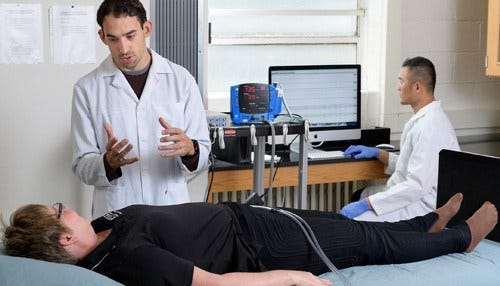Astronaut ‘Space Pants’ Show Promise for PAD Patients
 Roseguini uses warm water to apply constant heat to the legs and promote increased blood flow.
Roseguini uses warm water to apply constant heat to the legs and promote increased blood flow.
Subscriber Benefit
As a subscriber you can listen to articles at work, in the car, or while you work out. Subscribe NowSpecial garments designed to keep astronauts cool while performing demanding spacewalks could help patients here on Earth, says a Purdue University researcher. NASA astronauts wear liquid cooling and ventilation garments—which look much like long underwear—beneath their bulky spacesuits; the stretchy spandex material holds 300 feet of tubing that circulates chilled water. Purdue Health and Kinesiology Assistant Professor Dr. Bruno Roseguini believes the outer space strategy could help millions of people with Peripheral Artery Disease (PAD), and he aims to prove his theory on dozens of Hoosier patients.
PAD is characterized by insufficient blood flow to arteries in the legs, caused by plaque buildup that narrows the arteries. Walking around or exercising aggravates the condition, causing pain, cramping or fatigue, typically in the calf muscles. The American Heart Association says 8.5 million Americans suffer from the disease, and it’s an increasingly common problem in the elderly.
“Patients have told me, ‘I’m willing to do anything to get rid of this pain.’ Some have difficulty going to the grocery, and in extreme cases, just going to the mailbox,” says Roseguini. “If you don’t do anything about it, the patient will decline functionally a lot faster than a normal elderly person.”
Roseguini has tweaked astronauts’ gear to create his own version of the “space pants.” Rather than circulating chilled water, Roseguini uses warm water to apply constant heat to the legs and promote increased blood flow. His early study is showing promising results for PAD patients.
“So far, what we know for sure is there’s an improvement in blood flow; blood flow goes up when you use these pants, even to the most symptomatic leg,” says Roseguini.
It could be a welcome relief for patients with limited treatment options. Roseguini notes patients can undergo surgery that places stents to open clogged arteries, but it’s invasive, expensive and may only provide relief for one-to-three years before the artery is obstructed again.
Roseguini says exercise is the “gold standard” treatment, but patients find it very difficult to comply, because exercise is often painful. He believes combining the pants with exercise could, ultimately, produce the maximum benefit.
“One unique thing about using a liquid-circulating garment is the portability. You could wear them before and while exercising,” says Roseguini. “If the patient wants to go to the grocery, you could apply the therapy 30 minutes before the trip, go to the store while the pump is circulating water through the pants, and the body is being warmed up. Our expectation is this will reduce pain, so they have a better ability to move while performing these activities.”
But first, he must prove the effectiveness of the pants with repeated use. Roseguini is launching a clinical trial with the Indiana University School of Medicine to test the pants with about 30 PAD patients. Funded by the American Heart Association, the trial will involve patients wearing the pants for three, 90-minute sessions per week over the course of six weeks.
“Our expectation is if you do that over time, the function of the arteries in the legs—the ability of the arteries to basically open up during exercise, and therefore, increase the ability to deliver oxygen to the muscle—will be enhanced,” says Roseguini. “That would translate to less pain and potential improvements in walking capacity.”
Roseguini’s ultimate goal is to develop an affordable, convenient treatment that a patient could self-administer in the comfort of their own home.
“My impression so far is that patients seem to like heat therapy, and I’m excited about the future prospect of that,” says Roseguini. “I think we’ve found something they might enjoy in the long-term, and if effective, this could have a significant impact on a substantial chunk of the population that suffers from the disease.”
Roseguini believes the pants have the potential to overcome the barriers associated with other treatment options.
Although his method will use warm water to deliver heat therapy, Roseguini says NASA developed the garment to keep astronauts cool while hard at work.
